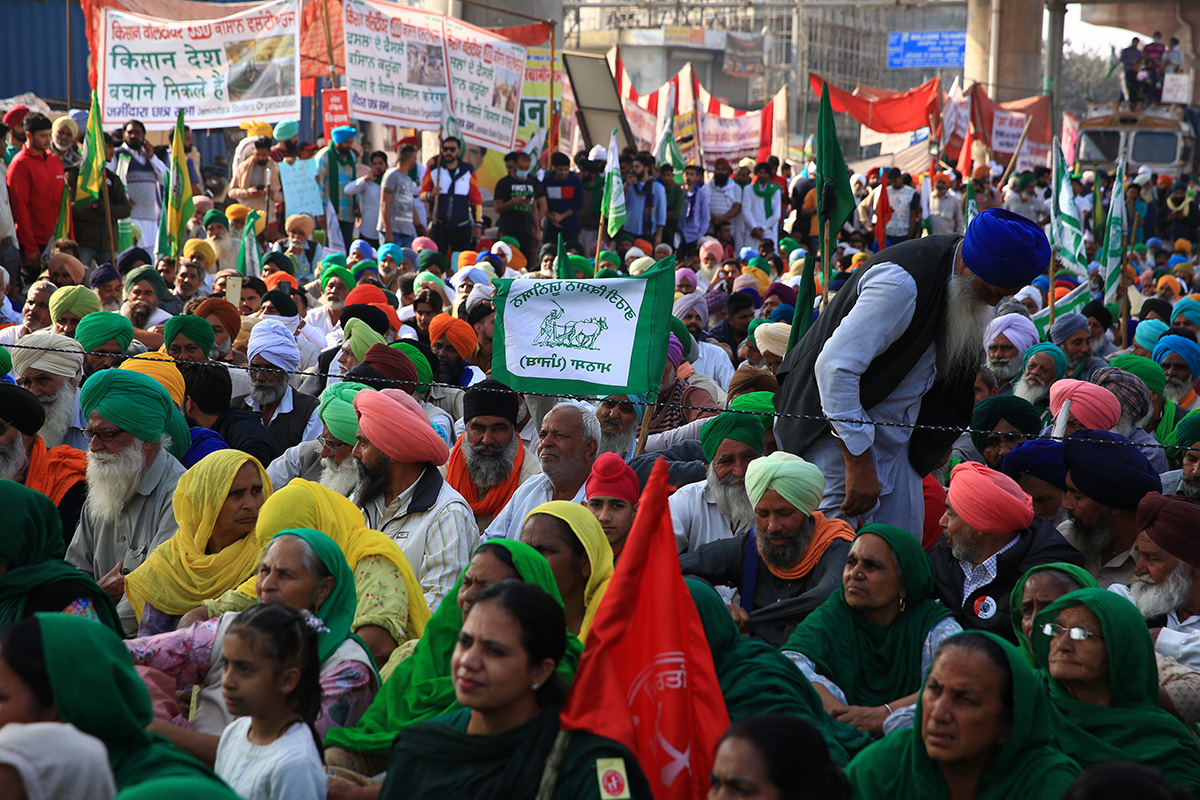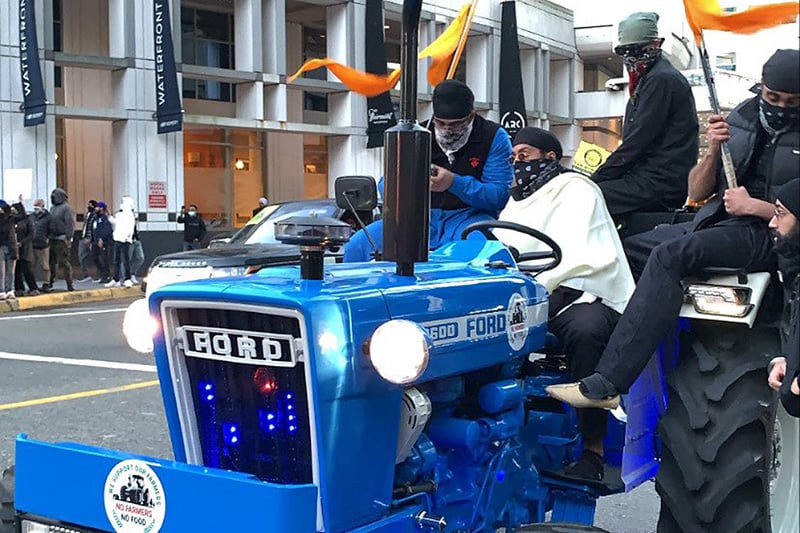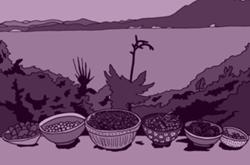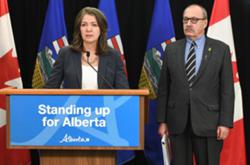“Zindabad!” The celebratory rallying cry is being sounded by hundreds of millions of farmers protesting in the streets of Delhi — and it rings out from growing car parades and rallies in British Columbia’s Lower Mainland over recent weeks. More are planned.
The cheer is translated by some as “Long live!" and has been chanted in freedom movements throughout South Asian history — including by those in independence and labour movements.
Hundreds rallied last week in Vancouver and Surrey as India plummeted into a nationwide general strike over controversial agriculture reforms — reforms the country’s far-right government says are necessary to “modernize” the sector.
Before that, large numbers turned up across the Lower Mainland for several days of local solidarity protests on Dec. 2 and 5, waving signs such as, “Justice for Farmers.” From Surrey to Richmond and Granville Island market, pickup trucks have been seen sporting the placards, too.
And as massive protests continued to blossom on India’s streets, “Zindabad!” echoed inside B.C.’s own legislature last week with the election of Burnaby-Edmonds MLA Raj Chouhan as Speaker — the first South Asian in such a role in North America.
Nearly one-in-ten British Columbians have South Asian ancestry, according to Statistics Canada; over half live in Surrey. Of them, two-thirds are Sikh, a faith with origins in India's northeastern Punjab state — called the country's "breadbasket" as it plays an outsized role in Indian farm output.
Forty years ago this year, Chouhan helped found Canada’s first labour unit for farmworkers, the Canadian Farmworkers' Union — sparking a series of certification victories and legislative reforms, and enthusiastic visits from U.S. farmer hero César Chávez.
“I never, ever thought that one day I would be in this position when I immigrated to Canada in 1973,” said newly-elected Chouhan in his first speech Dec. 7. “In the '70s, when we organized farmworkers, I was not alone.... Thank you... Zindabad!”
Chouhan raised his fist as he spoke, which “choked up” Delta single mother and communications professional Mita Naidu. Chouhan gave “a beautiful tribute to his farmworker and labour union roots,” she said. The moment was emotional for all South Asians, she added, since Chouhan is the first South Asian elected to the position in Canada.
B.C.’s farmer and farmworker rights movements are decades old, but today the struggles continue here, experts say, and they are related to global trends. Given the strong and complex connections between B.C.’s large South Asian population and events in India, The Tyee offers this explainer.
Just how big are the protests in India?
They’ve been called the “largest protests in human history,” with media reports of between 200 to 300 million people taking part in demonstrations in late November, according to India Today and Slate.
The so-called “Dilli Chalo” (“Let's go to Delhi”) rallies last month saw authorities dig trenches in a failed attempt to stop crowds from multiple states entering the capital — culminating in police attacking elderly participants with batons and water cannons, sparking outcry from human rights organizations.
Those were followed by a massive national general strike Tuesday, Dec. 8, with the support of the country’s massive trade unions.
One of the British Columbians watching keenly is author Shauna Singh Baldwin, who told The Tyee she is both inspired — and incensed by the Indian government labelling farmers as terrorists and separatists.
“What seems to be the largest protest in human history is taking place in India,” said the author of the Giller Prize-shortlisted The Tiger Claw and Commonwealth-winning novel What the Body Remembers. “Farmers all over India are protesting laws suddenly passed by the government of India — in favour of Indian and transnational oligarchs.”
So what are the protests about?
Three pieces of farm-related legislation passed in India’s Parliament nearly three months ago are at the heart of the protests, but the crisis has been simmering for decades.
They deal with long-standing government protections of small farmers, the prices they can get for their crops, and who can access the 1.4-billion resident country’s lucrative food supply chain.
The three bills passed on Sept. 27, immediately sparking protests that have only grown in size since.
The bills are quite technical and complex, but India’s Prime Minister Narendra Modi tweeted that they represent a “watershed moment in the history of Indian agriculture” and would bring a “complete transformation of the agriculture sector.”
Modi said they are intended to “modernize” India’s agricultural economy and liberate farmers from middlemen who take a cut.
Opponents counter the bills are forcing damaging neoliberal market reforms onto farmers — to help multinational corporations increase their access and control over the sector.
One law, the Farmers' Produce Trade and Commerce Act, ends regional restrictions on where farm produce can be sold, allowing electronic sales anywhere in the country.
The second, the Farmers Agreement on Price Assurance and Farm Services Act, bans governments charging market access fees, and forces farmer-buyer disputes to arbitrators instead of the courts.
And finally, the Essential Commodities Amendment Act updated a 65-year-old bill created to safeguard food security and protect farmers. It gutted protections on several key crops including grains, now only allowing the government to intervene in those crops’ prices in a famine or war, and only based on free market price increases.
Modi boasted the reforms would bring the “complete transformation of the agriculture sector,” and for supporters that means “modernizing” what they say are outdated market controls.
“Complete transformation” is also precisely what millions of protesting small farmers fear.
The farmers counter the bills gut the longstanding minimum guaranteed price that small farmers — many of them with only a few acres to their name — have for decades received for their crops, effectively equivalent to an agricultural minimum wage.

Opponents counter the bills will help multinational corporations increase their control over the sector and drive out small farmers.
The government insists nothing in the new laws actually eliminates the minimum support prices, MSP.
But opponents say even if MSP is not on the table officially, the reforms will pave the way for ending state protections to empower farming mega-corporations.
“It’s couched in the language of empowerment and free markets,” explained Vancouver’s Mo Dhaliwal, with the Poetic Justice Foundation, “but in a truly free market a lot of predatory and violent practices can take place.
“They’ll be able to essentially kill crop prices to a point where farming becomes untenable for small farmers… and corporations are poised and ready to swoop and buy up their land.”
How do the farm bills fit into India’s current political reality?
India’s government is led by far-right Prime Minister Narendra Modi. Since his Hindu nationalist Bharatiya Janata Party, or BJP, was elected to power in 2014, tensions have been growing with many of India’s social movements and marginalized ethnic communities.
Modi has long been criticized for policies seen as pushing for India to be a Hindu state, not a secular one as it was envisaged — as well as policies accused of targeting India’s Muslim minority.
In fact, India is also nearing one year since major protests by Muslims against BJP policies sparked a government crackdown and accusations of human rights abuses. Modi’s government effectively shuttered Amnesty International’s entire operations in the country by freezing its assets and accusing it of “sedition.” The organization hasn’t spoken out about the latest protests, and says it’s been silenced since September.
Modi’s BJP controls 56 per cent of seats in the largest body of government, the Lok Sabha (equivalent to Congress or Parliament), and just 38 per cent of the smaller, upper house, the Rajya Sabha (equivalent to a Senate). The government’s opposition is the Indian National Congress, which after ruling the country in a coalition plummeted to just eight per cent of the lower house seats in the 2014 election.
What is happening in British Columbia?
At every stage of the protests in India, B.C. has seen noisy and vibrant solidarity protests outside Indian government outposts in downtown Vancouver and Surrey, as well as several other cities. Many of the rallies have been organized as car parades, because of the pandemic.
There’s a nightly rally in Surrey on Scott Rd and 72 Ave for the #FarmersProtest. We drive by tonight & my heart was touched.
— Manveer Singh (@manveerssihota) December 7, 2020
There was a Muslima holding a “Muslims for Sikhs” sign, a Black sister with a “Black Lives for Punjabi Farmers” sign, ans protesters serving hot chaa. ❤️ pic.twitter.com/A8hAYv5j9a
The last car rally was in Vancouver on Dec. 10, coinciding with India’s general strike. And more are planned, organizers say, on Dec. 20, followed by Dec. 24 and 31.
Dhaliwal said for Canadians who emigrated from Punjab over decades, most of them Sikh, the plight of farmers is “intimate.”
“A majority of Sikhs in Canada are from farming backgrounds,” Dhaliwal said. “The reason such an exodus to this extent occurred from Punjab has to do with the economic and social justice issues in India.”
What is inspiring response by B.C.’s South Asian community, and Sikhs in particular?
Dhaliwal said the Indian farmer rights issue is hardly a new one. For years, he’d been watching with dismay as suicides among India’s farmers — including in Punjab state — climbed into the tens of thousands as crippling debts and dire economic conditions drove families to the brink.
“There’s been more attention on farmer suicides in the Punjab,” Dhaliwal said. “It was largely due to the fact there were predatory finance schemes introduced that had many farmers literally betting their livelihood on a successful crop.
“This crippled them — it crippled their ability to even live, let alone repay their debt.”
He said the financial strains, combined ecological depletion and massive agro-corporations gaining more power and land, have put Punjabis’ way of life and links to the land in jeopardy.
And Punjab, known as India’s fertile “breadbasket,” was no longer as fertile or water-rich as industrial, massive-scale farming took over.
All these combined to see farming there, he said, “dying of a thousand cuts.”
For Harsha Walia, executive director of the B.C. Civil Liberties Association and a director of the South Asian Network for Secularism and Democracy, the fact that many who left Punjab turned to farming in B.C. is no accident.
“They are largely farmworkers and farmers, especially from the 1980s onward,” she said. “They were farmers who faced down the counterinsurgency of the Indian state. And many continued to farm here.”
The demonstrations have also tapped into a long tradition of Sikh activism and organizing in Canada. They have put Sikh culture and values into the spotlight. Music has played an outsized role in the demonstrations here and abroad, as well as Sikh principles such as feeding the masses for free.
Cars as far as the eye can see at the Kisaan Morcha car rally waiting to drive from Surrey to Vancouver. This is just our section of cars waiting. So many more lined up. #IStandWithFarmers #FarmerProtests #NoFarmersNoFood #KisaanMorcha pic.twitter.com/dVnHZrDpa6
— Manveer Singh (@manveerssihota) December 5, 2020
That is what most inspired the Poetic Justice Foundation’s co-founder Mo Dhaliwal — who’s vocally supporting demonstrators and helping amplify their message on social media. He was moved by scenes of food being served to not just protesters, but also thousands of impoverished Delhi children and even soldiers.
“Those have actually been the most inspiring moments,” said Dhaliwal. “There’s been moments that have harkened back to stories of centuries prior.
“It’s the Sikh way of protesting — it’s a Sikh-led movement, but (those) tend to be very intersectional: they’re for human rights, you’ll see people of all caste and creed coming together.”
Are there other connections to issues in BC and Canada?
Canada saw its Canadian High Commissioner in India summoned for a scolding over Prime Minister Justin Trudeau’s remarks in support of free expression and the farmers protests — which the Indian government decried as “unacceptable interference” in domestic issues.
And New Democrat Leader Jagmeet Singh — Canada’s first South Asian leader of a major party — also added his support for the farmers.
“The violence perpetrated by the Indian (government) against farmers peacefully protesting is appalling,” Singh, who represents Burnaby South in Parliament, tweeted on Nov. 28. “I stand in solidarity (with) the farmers from Punjab and across India — and, I call on the Indian govt to engage in peaceful dialogue rather than violence.”
But perhaps one of the most striking things in common here in B.C. is the province’s own history of farmer and farmworker struggles to improve their conditions. And there is no better example of that than the founding of the Canadian Farmworkers’ Union in 1980, marking its 40th anniversary this year.
The CFU emerged out of the two-year-old Farmworkers Organizing Committee, and within a short time had certified the country’s first agricultural union and spread across Canada. In 1993, the provincial NDP government adopted a series of sweeping reforms demanded by the CFU, including work safety standards in line with other industries.
“There was a very strong mobilization particularly of South Asian and Punjabi farmworkers in B.C., because so many worked in the farms,” Walia said.
Today, Walia said, the terrain has shifted and more South Asian farmers own their own land in B.C. and employ others to harvest it. She hopes that solidarity with their counterparts in India also translates into solidarity with struggling for their rights here.
“One slogan of the protests is ‘Kisaan majdoor ekta zindabad!’ — ‘farmers and farmworkers united!’” she said. “How do we show up for farmworkers here, especially migrant farmworkers who may not be Punjabi, but they’re still growing our food?”
What are reasons for British Columbians to closely follow what happens in India?
Some here see moves to deregulate agriculture in India as in lockstep with similar corporate pushes in other nations worldwide. And with ecology and food security at increasing odds with corporate influence, many Canadian farmers say they too are worried.
“The main thing people really need to take away from the farmers’ protest is just how significant it is, not only in India,” Walia said. “This is something very relevant all around the world — where we see major corporations increasingly having access and controlling our entire food supply chain.”
If protections on small farmers from the whims of the free market can be gutted in the world’s largest democracy, critics fear agricultural corporations will push for that everywhere.
That’s why Canada’s National Farmers Union said it’s supporting their Indian counterparts, endorsing the demonstrations on Dec. 6.
“We in Canada recognize the Indian farmers’ struggle as similar to our own struggle,” said NFU president Katie Ward. “We support them in their right to protest, and in their call for agriculture policy that supports the millions of smallholder farmers growing food in India... and open them up to exploitation by large corporations.”
This country’s own Canadian Wheat Board, for instance — created in the Great Depression to prevent a race to the bottom in crop prices — was shuttered by the former Conservative government in 2015.
For others, what’s happening in Indian politics more broadly — the world’s most populous democracy — bodes ill for democracies everywhere.
“If laws bypassing the entire legal system... are passed in India, they can be passed to undermine any democracy,” author Singh Baldwin told The Tyee. “Today they affect farmers in Punjab, Rajasthan, Haryana and all the states in India.
“Tomorrow they will come to North America.” ![]()
Read more: Local Economy, Rights + Justice, Labour + Industry, BC Politics















Tyee Commenting Guidelines
Comments that violate guidelines risk being deleted, and violations may result in a temporary or permanent user ban. Maintain the spirit of good conversation to stay in the discussion.
*Please note The Tyee is not a forum for spreading misinformation about COVID-19, denying its existence or minimizing its risk to public health.
Do:
Do not: